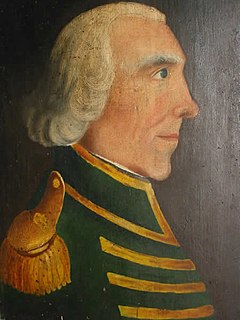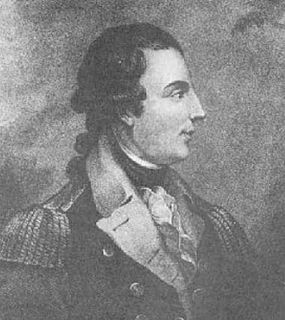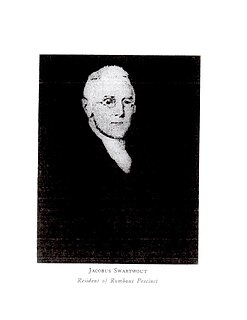 W
WThe John Allen Farm massacre occurred in South Argyle, Washington County, New York on 25 or 26 July 1777 during the advancement of the British Army in the Saratoga Campaign of the American Revolutionary War. Six members of the John Allen family and two or three slaves loaned to the Allen's were killed by Native Americans attached to General John Burgoyne's British Army. Subsequently, Native Americans led by the warrior Le Loup attacked and killed Jane McCrae in nearby Fort Edward on 27 July; which garnered publicity in newspapers along the eastern seaboard of America and is believed to have helped rally locals to the American patriotic cause.
 W
WDaniel Frederick Bakeman was the last survivor receiving a veteran's pension for service in the American Revolutionary War (1775–1783).
 W
WAnn Eliza Bleecker was an American poet and correspondent. Following a New York upbringing, Bleecker married John James Bleecker, a New Rochelle lawyer, in 1769. He encouraged her writings, and helped her publish a periodical containing her works.
 W
WJohn Butler (1728–1796) was a Loyalist who led an irregular militia unit known as Butler's Rangers on the northern frontier in New York during the American Revolutionary War. Born in Connecticut, he moved to New York with his family, where he learned several Iroquoian languages and worked as an interpreter in the fur trade. He was well-equipped to work with Mohawk and other Iroquois Confederacy warriors who became allies of the British during the rebellion.
 W
WThe Captivity of Benjamin Gilbert and His Family, 1780-83 is a captivity narrative by William Walton relating the experiences of a Quaker family of settlers near Mauch Chunk in present-day Carbon County, Pennsylvania. The story was originally published in 1784, and has since been republished numerous times under varying titles.
 W
WMargaret Cochran Corbin was a woman who fought in the American Revolutionary War. On November 16, 1776, her husband, John Corbin, was one of some 600 American soldiers defending Fort Washington in northern Manhattan from 4,000 attacking Hessian troops under British command. Margaret, too nervous to let her husband go into battle alone, decided she wanted to go with him. Since she was a nurse, she was allowed to accompany her husband as a nurse for injured soldiers. John Corbin was on the crew of one of two cannons the defenders deployed; when he fell in action, Margaret Corbin took his place and continued to work the cannon until she too was seriously wounded. It is said that Corbin was standing next to her husband when he fell during battle. Immediately, she took his post, and because she had watched her husband, a trained artilleryman, fire the cannon so much, she was able to fire, clean and aim the cannon with great ease and speed. This impressed the other soldiers and was the beginning of her military career. She later became the first woman in U.S. history to receive a pension from Congress for military service when she could no longer work due to injury, and was enlisted into the Corps of Invalids.
 W
WGeneral Oliver De Lancey, also known as Oliver De Lancey Jr., was a British Army officer of French Huguenot descent, from a prominent family in colonial era New York state. His surname is sometimes written as de Lancey or DeLancey.
 W
WSamuel Fraunces was an American restaurateur and the owner/operator of Fraunces Tavern in New York City. During the Revolutionary War, he provided for prisoners held during the seven-year British occupation of New York City (1776-1783), and claimed to have been a spy for the American side. At the end of the war, it was at Fraunces Tavern that General George Washington said farewell to his officers. Fraunces later served as steward of Washington's presidential household in New York City (1789–1790) and Philadelphia (1791–1794).
 W
WAquila Giles was an American lawyer, politician and soldier from Brooklyn who served in the New York State Assembly.
 W
WSir John Johnson, 2nd Baronet was a leading figure in the British Indian Department, a Loyalist leader during the American Revolution, a magistrate in Canada, and a wealthy landowner. He was the son of Sir William Johnson, 1st Baronet, who was the first British Superintendent of Indian Affairs.
 W
WSybil Ludington, April 5, 1761 – February 26, 1839, was a heroine of the American Revolutionary War. On April 26, 1777, the 16 year-old daughter of a colonel in the Colonial militia, Henry Ludington, made an all-night horseback ride to alert militia forces in the neighboring towns of what is today's Putnam County, New York of the burning of Danbury, Connecticut by British forces.
 W
WHenry Ludington was an American businessman who ran a grist mill and owned a substantial parcel of land in New York state. He founded Ludingtonville, which later became the town of Kent, New York. He lived in Patterson, New York, for four decades and was involved with its growth.
 W
WNelson Ludington was a nineteenth-century American businessman, lumber baron and banker. Born in Ludingtonville, New York, he made his fortune in the Midwest based on resource exploitation: lumber, iron ore and copper.
 W
WJane McCrea was an American woman who was killed by a Native American warrior serving alongside a British Army expedition under the command of John Burgoyne during the American Revolutionary War. Engaged to a Loyalist officer serving under Burgoyne, her death lead to widespread outrage in the Thirteen Colonies and was used by Patriots as part of their anti-British propaganda campaign.
 W
WMary Lindley Murray is known in the American Revolution as the Quaker woman who in 1776 held up British General William Howe after the British victory against American forces at Kips Bay.
 W
WHaym Salomon was a Polish-born Jewish businessman and political financial broker who, along with English-born Robert Morris, was a prime financier of the rebel American side during the American Revolutionary War against Great Britain.
 W
WJacobus Swartwout (1734–1827) was an early American landowner, statesman, and military leader. Swartwout served as a Brigadier General in the Continental Army during the American Revolutionary War under General George Washington. He was a close ally of many key Founding Fathers of the United States, and a delegate to New York State's convention for ratification of the US Constitution.
 W
WRobert Townsend was a member of the Culper Ring during the American Revolution. He operated in New York City with the aliases "Samuel Culper, Jr." and "723" and gathered information as a service to General George Washington. He is one of the least-known operatives in the spy ring and once demanded Abraham Woodhull never to tell his name to anyone, even to Washington.
 W
WSolomon Townsend was a merchant ship's captain prior to the American Revolution, owned an ironworks in New York State, and was a representative to the New York State Legislature. Stranded in London following the outbreak of hostilities, Townsend's passage back to America was facilitated by Benjamin Franklin. After the war he was a successful owner of an iron works plant, and a member of the New York State Legislature. One of his children followed him into the legislature and another was a founder of what became the New York Academy of Sciences.
 W
WHenry Wisner was an American miller from Goshen, New York. He was a patriot leader during the American Revolution who voted for Independence on July 4, 1776 at the creation of the Declaration of Independence, and represented New York in the Continental Congress.
 W
WPatience Lovell Wright was a sculptor of wax figures, and the first recognized American-born sculptor.